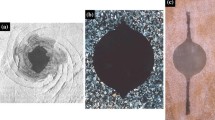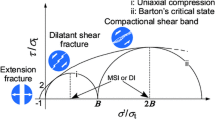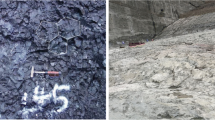Abstract
Drilling experiments in rock blocks subjected to pre-existing true triaxial far-field stresses simulating real in situ conditions often result in localized failure around the created borehole, which brings about the formation of borehole breakouts. In weakly bonded quartz-rich porous sandstones breakouts take the form of narrow tabular (slot-like) openings extending along a plane perpendicular to the maximum applied-stress direction. Scanning electron microscopes images of failed boreholes strongly suggest that these breakouts are compaction bands that have been emptied to different extents. The bands form as a result of the stress concentration accompanying the creation of the borehole. The evacuation of the compaction bands is brought about by the circulating drilling fluid flushing out debonded and often fragmented grains from within these bands (Haimson and co-workers, 2003–2007). The objective of this paper is to predict the conditions under which compaction bands are formed around boreholes. To this end, a new analytical model is formulated that enables prediction of the stress field around emptied and filled compaction bands, the various factors affecting the breakouts lengths, and their final length. Good agreement of the developed analytical model with experimental results obtained by Haimson and co-workers (Haimson and Klaetsch in Rock physics and geomechanics in the study of reservoirs and repositories, vol 284, pp 89–105, 2007; Haimson and Kovachich in Eng Geol 69:219–231, 2003; Klaetsch and Haimson in Mining and tunneling innovation and opportunity, University of Toronto press, pp 1365–1371, 2002; Sheets and Haimson in Proceedings, paper ARMA/NARMS 04-484, 2004) is demonstrated. The presented study is of practical relevance: boreholes are often drilled deep into weak porous sandstone formations for the purpose of extracting oil and gas, and the question of borehole stability is crucial. In addition, borehole breakouts are often used to estimate the state of stress in the Earth’s crust, and our new formulation will help improve these estimates.









Similar content being viewed by others
References
Baud P, Klein E, Wong T-F (2004) Compaction localization in porous sandstones: spatial evolution of damage and acoustic emission activity. J Struct Geol 26(4):603–624
Baud P, Vajdova V, Wong T-F (2006) Shear-enhanced compaction and strain localization: inelastic deformation and constitutive modeling of four porous sandstones. J Geophys Res. doi:10.1029/2005jb004101
Brudy M, Zoback MD, Fuchs K, Rummel F, Baumgartner J (1997) Estimation of the complete stress tensor to 8 km depth in the KTB scientific drill holes: implications for crustal strength. J Geophys Res Solid Earth 102(B8):18453–18475
Dresen G, Stanchits S (2008) Borehole breakouts and sand production in porous sandstone. Geophys Res Abstr, EGU General Assembly 2008, 10: EGU2008-A-07172
Eshelby JD (1957) The determination of the elastic field of an ellipsoidal inclusion, and related problems. Proc R Soc Lond (A). Math Phys Sci 241(1226):376–396
Fairhurst C (1968) Methods of determining in situ rock stresses at great depth. Technical report I-86, Missouri River Division, US Army Corps of Engineers
Germanovich LN, Dyskin AV (2000) Fracture mechanisms and instability of openings in compression. Int J Rock Mech Mining Sci 37(1–2):263–284
Gough DI, Bell JS (1981) Stress orientations from oil-well fractures in Alberta and Texas. Can J Earth Sci 18(3):638–645
Haimson BC (2003) Borehole breakouts in Berea Sandstone reveal a new fracture mechanism. Pure Appl Geophys 160:813–831
Haimson BC (2007) Micromechanisms of borehole instability leading to breakouts in rocks. Int J Rock Mech Mining Sci 44(2):157–173
Haimson BC, Chang CD (2002) True triaxial strength of the KTB amphibolite under borehole wall conditions and its use to estimate the maximum horizontal in situ stress. J Geophys Res Solid Earth 107(B10):2257
Haimson BC, Herrick C (1986) Borehole breakouts—a new tool for estimating in situ stress? In: Stephansson O (ed) Rock stress. CENTEK Publishers, Lulea, pp 271–280
Haimson BC, Klaetsch A (2007) Compaction bands and the formation of slot-shaped breakouts in St. Peter sandstone. Rock Physics and Geomechanics in the Study of Reservoirs and Repositories 284:89–105
Haimson BC, Kovachich J (2003) Borehole instability in high-porosity Berea sandstone and factors affecting dimensions and shape of fracture-like breakouts. Eng Geol 69:219–231
Haimson BC, Song I (1993) Laboratory study of borehole breakouts in cordova cream—a case of shear failure-mechanism. Int J Rock Mech Mining Sci Geomech Abstr 30(7):1047–1056
Haimson BC, Song I (1998) Borehole breakouts in Berea Sandstone: two porosity-dependent distinct shapes and mechanisms of formation. Rock Mech Petrol Eng Soc Pet Eng 1:229–238
Issen KA, Rudnicki JW (2000) Conditions for compaction bands in porous rock. J Geophys Res 105(B9):21529–21536
Issen KA, Rudnicki JW (2001) Theory of compaction bands in porous rock. Phys Chem Earth (A) 26(1–2):95–100
Jaeger JC, Cook NGW (1976) Fundamentals of rock mechanics. Chapman & Hall, London
Katsman R, Aharonov E, Scher H (2005) Numerical simulation of compaction bands in high-porosity sedimentary rock. Mech Mat 37(1):143–162
Katsman R, Aharonov E (2006) A study of compaction bands originating from cracks, notches, and compacted defects. J Struct Geol 28(3):508–518
Katsman R, Aharonov E, Scher H (2006a) A numerical study on localized volume reduction in elastic media: some insights on the mechanics of anticracks. J Geophys Res. doi:10.1029/2004JB003607
Katsman R, Aharonov E, Scher H (2006b) Localized compaction in rocks: Eshelby’s inclusion and the Spring Network Model. Geophys Res Let 33(10):L10311
Klaetsch AR, Haimson BC (2002) Porosity-dependent fracture-like breakouts in St. Peter sandstone. In: Hammah R et al. (eds) Mining and tunneling innovation and opportunity, University of Toronto press, pp 1365–1371
Klein E, Baud P, Reuschle T, Wong T-f (2001) Mechanical behaviour and failure mode of bentheim sandstone under triaxial compression. Phys Chem Earth (A) 26(1–2):21–25
Mollema PN, Antonellini MA (1996) Compaction bands: a structural analog for anti-mode I cracks in aeolian sandstone. Techtonophysics 267(1–4):209–228
Murakami Y (1987) Stress intensity factors handbook. Soc Mater Sci, Japan
Olsson WA (2001) Quasistatic propagation of compaction fronts in porous rock. Mech Mater 33:659–668
Reinecker J, Heidbach O, Tingay M, Sperner B, Müller B (2005) The release 2005 of the World Stress Map. Available at http://www.world-stress-map.org
Scholz CH (2000) The mechanics of earthquakes and faulting. Cambridge University Press, Cambridge
Sheets RJ, Haimson BC (2004) Drilling variables affecting fracture-like borehole breakout characteristics. In Gulf rocks 2004, reviewed CD-Rom Proceedings, paper ARMA/NARMS 04-484
Sih GC (1973) Handbook of stress–intensity factors: stress-intensity factor solutions and formulas for reference. Bethlehem, Pa.: Institute of Fracture and Solid Mechanics, Lehigh University
Song I, Haimson BC (1997) Polyaxial strength criteria and their use in estimating in situ stress magnitudes from borehole breakout dimensions. Intl J Rock Mech Mining Sci 34(3–4):116
Tembe S, Vajdova V, Wong T-f, Zhu W (2006) Initiation and propagation of strain localization in circumferentially notched samples of two porous sandstones. J Geophys Res Solid Earth 111(B2):B02409
Vajdova V, Wong T-f (2003) Incremental propagation of discrete compaction bands: acoustic emission and microstructural observations on circumferentially notched samples of Bentheim. GRL 30(14):1775
Vajdova V, Wong T-f, Farell DE, Issen KA, Challa V (2003) Experimental observation and numerical simulation of initiation and propagation of compaction bands in a sandstone. In: Proceedings ASCE engineering mechanics conference, Seattle, July 16–18
Vernik L, Zoback MD (1992) Estimation of maximum horizontal principal stress magnitude from stress-induced well bore breakouts in the cajon pass scientific-research borehole. J Geophys Res Solid Earth 97(B4):5109–5119
Acknowledgments
The research work of Aharonov and Katsman is supported by grants from the Israel Science Foundation No.732/05 and No.571/08. Haimson’s contribution was supported by the US Office of Basic Energy Sciences, US Department of Energy Grant DE-FG02-98ER14850. We thank both reviewers for their thorough reviews and helpful suggestions.
Author information
Authors and Affiliations
Corresponding author
Rights and permissions
About this article
Cite this article
Katsman, R., Aharonov, E. & Haimson, B.C. Compaction bands induced by borehole drilling. Acta Geotech. 4, 151–162 (2009). https://doi.org/10.1007/s11440-009-0086-3
Received:
Accepted:
Published:
Issue Date:
DOI: https://doi.org/10.1007/s11440-009-0086-3




